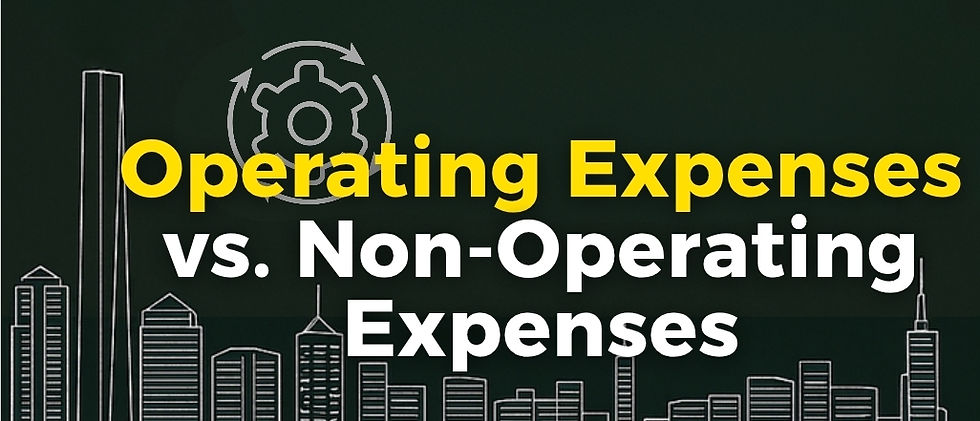Operating Expenses vs. Non-Operating Expenses (and why Operating Profit is not the same thing as EBIT)
- Graziano Stefanelli
- Jun 6
- 5 min read

1. Why the distinction matters
Every set of financial statements tries to answer a single question: How well is the core business engine working?
Operating expenses (OPEX) represent the repeatable costs that must be paid in order to sell products or deliver services.
Non-operating expenses (NOE) arise from financing choices, investing activities, or truly one-off events.
Splitting the two gives decision-makers a clean view of day-to-day efficiency before the noise of debt structuring, asset sales, or currency swings clouds the picture. The next step is to decide which performance subtotal to focus on:
Key nuance: Operating Profit is a purist view of core operations; EBIT adds extra earnings (or losses) that result from capital-allocation choices but still precede financing and tax.
2. Core definitions — OPEX vs. NOE
Grey areas exist. A hedging gain for an airline may be operating (hedging jet-fuel is integral to operations), whereas the same fair-value gain for a retailer is non-operating.
3. Accounting-rule backdrop
3.1 IFRS — IFRS 18 (effective 2027)
Introduces five mandatory categories: Operating, Investing, Financing, Income-tax, Discontinued.
Operating Profit is the residual for non-financial entities.
Adds a new required subtotal: Profit before financing & income taxes — effectively EBIT.
Financial institutions get bespoke guidance (interest is operating for a bank).
3.2 US GAAP — ASC 225 & Regulation S-X
Still permits one-step or multi-step statements but demands clear separation of operations from “other income/expense.”
Investing gains/losses and JV results appear below Operating Profit but above interest and tax, aligning with EBIT.
Companies often present custom “Adjusted Operating Income” or “Adjusted EBIT” bridges; read footnotes to see exactly what was excluded.
3.3 Local GAAP & tax quirks
Accelerated tax depreciation can inflate OPEX versus IFRS reporting.
High-inflation economies may show “monetary correction expense,” blurring categories.
Always reconcile management’s alternative performance measures (APMs) back to statutory subtotals.
4. Practical classification decision tree
Is the cost necessary to make or sell the product/service every period?
Yes ➜ Operating.
Would the cost disappear if the company had zero debt and never traded long-term assets?
Yes ➜ Non-operating.
Is the item unusual or infrequent?
One-offs (earthquakes, lawsuits, exit costs) normally flow below Operating Profit.
Industry carve-outs?
For banks, interest expense is operating; for miners, closure costs may be operating if recurring across mines.
5. Statement anatomy — where each subtotal sits
Revenue
└── Cost of goods sold (COGS)
└── Gross profit
└── Operating expenses (SG&A, R&D, D&A…)
└── Operating Profit
± Investing gains/losses, share of JV income
└── EBIT ←─ “Profit before financing & income taxes”
├── Net interest & financing FX
└── Profit before tax
└── Income tax
└── Net profit
Read-through example
6. Examples across industries
7. Analytical implications
8. Management & investor insights
Cost-control playbook. Separate “controllable” OPEX (travel, variable marketing) from “strategic” OPEX (R&D, cloud infrastructure). Cutting the wrong line erodes revenue faster than it boosts margins.
Capital-structure levers. If interest expense overwhelms Operating Profit, refinancing, rate hedging, or deleveraging can lift net income with zero operational change.
Guidance transparency. Under IFRS 18, “Adjusted Operating Profit” must reconcile to statutory subtotals. Clear bridges build investor trust; sloppy ones raise red flags.
Dashboarding & re-classification. If a nominally “non-operating” cost recurs (e.g., annual restructuring), management should either stop calling it non-recurring or rethink the business model.
Investor red flags. A company showing robust Operating Profit but chronically negative net income likely suffers structural non-operating drags—heavy leverage, repeated write-downs, or ongoing litigation risk.
9. Emerging trends
Automation & AI tagging — Modern ERPs auto-classify expenses in real time, shrinking the month-end “where does this belong?” debate.
ESG-related costs — Routine carbon-credit purchases go in OPEX; environmental fines hit NOE. Watch for green-washing via re-classification.
Intangible economy — As goodwill and data dominate balance sheets, amortisation/impairment of acquired intangibles grows inside NOE; analysts adjust EBIT upward to gauge cash power.
Rate volatility — The post-2022 rate cycle magnifies the spread between fixed-rate and floating-rate borrowers, making the Operating Profit vs. EBIT gap more informative than ever.
Global convergence — IFRS 18 pushes comparability, but regional habits persist. Diligent analysts still read footnotes line by line.
10. Key takeaways
OPEX vs. NOE is the first cut; it separates core execution from financing and strategic noise.
Operating Profit reveals pure business performance; EBIT layers in investing results but stops short of financing costs.
New standards tighten presentation rules, yet judgement calls remain—especially in grey areas and industry carve-outs.
Investors and managers must scrutinise footnotes and cash-flow statements to see whether non-operating drags are one-time or structural.
Mastering these distinctions leads to better cost discipline, cleaner valuations, and sharper strategic decisions.
_____________
FOLLOW US FOR MORE.
DATA STUDIOS




